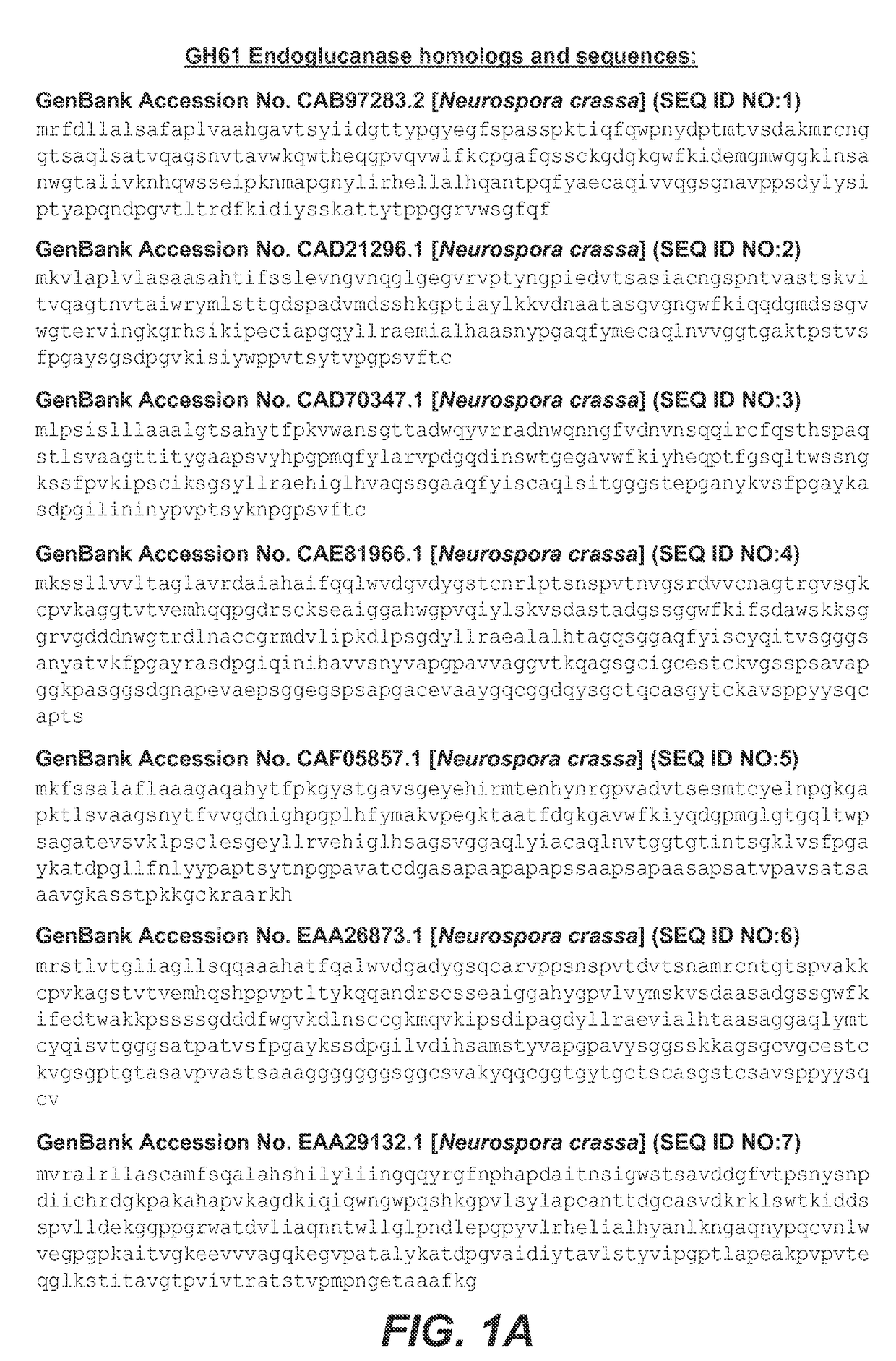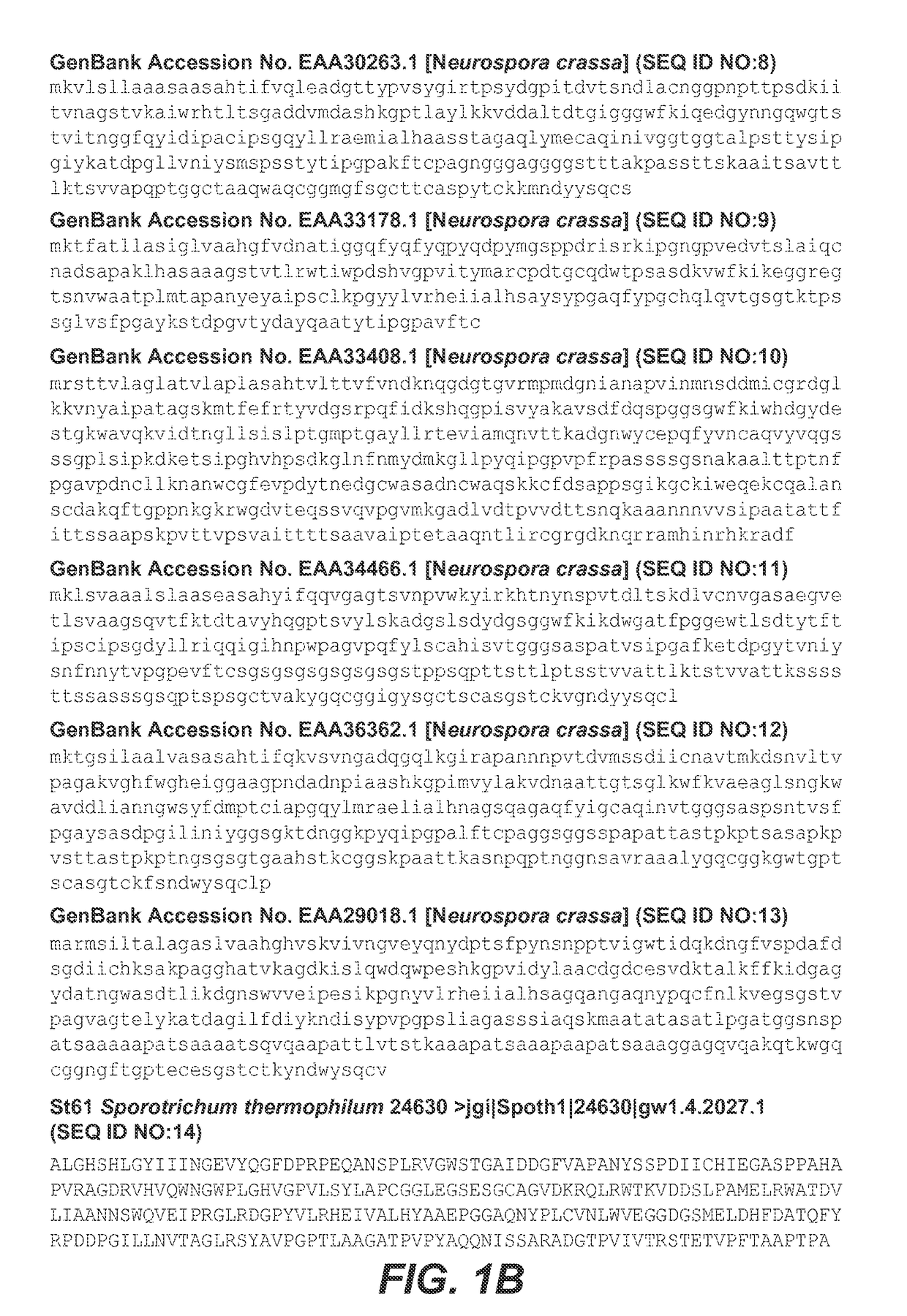Method for reducing viscosity in saccharification process
a technology of viscosity reduction and saccharification process, which is applied in the field of compositions, can solve the problems of slow ethanol conversion research, inability to achieve efficient degradation of whole cellulase, and inability to achieve natural-occurring whole cellulase, etc., and achieves the effect of improving the yield of desirable fermentable sugars, reducing the viscosity of the mixture, and improving the yield of saccharification
- Summary
- Abstract
- Description
- Claims
- Application Information
AI Technical Summary
Benefits of technology
Problems solved by technology
Method used
Image
Examples
example 1
thods
[0360]The following assays / methods were generally used in the Examples described below. Any deviations from the protocols provided below are indicated in specific Examples.
[0361]A. Pretreatment of Biomass Substrates
[0362]Corncob, corn stover and switch grass were pretreated prior to enzymatic hydrolysis according to the methods and processing ranges described in International Patent Publication WO06110901A (unless otherwise noted). These references for pretreatment are also included in the disclosures of US Patent Application Publications 20070031918-A1, 20070031919-A1, 20070031953-A1, and / or 20070037259-A1.
[0363]Ammonia fiber explosion treated (AFEX) corn stover was obtained from Michigan Biotechnology Institute International (MBI). The composition of the corn stover was determined by MBI (Teymouri, F et al. Applied Biochemistry and Biotechnology, 2004, 113:951-963) using the National Renewable Energy Laboratory (NREL) procedure, NREL LAP-002. NREL procedures are available at:...
example 12
cation Performance of Strain H3A / EG4#27 on Ammonia Pretreated Switchgrass
[0440]The saccharification performance of strain H3A / EG4#27 on ammonia pretreated switchgrass (International Patent Publication WO06110901A) at increasing protein doses was compared to that of strain H3A (18.5% solids). Pretreated switchgrass preparations were measured into 20 mL glass vials to give 0.925 g of dry solid. 1 N sulfuric acid and 50 mM pH 5.3 sodium acetate buffer (with 0.01% sodium azide) were added to give final slurry of 5 grams total reaction. The enzyme dosages of H3A tested were 14, 20, and 30 mg / g (glucan+xylan); and the dosages of H3A-EG4 #27 were 5, 8, 11, 14, 20, and 30 mg / g (glucan+xylan). The reactions were incubated at 50° C. for 3 d. Following incubation, the reaction contents were diluted 3-fold, filtered and analyzed by HPLC for glucose and xylose concentration. The conversion of glucan and xylan were calculated based on the composition of the switchgrass substrate. The results (FIG...
example 14
G4 Improves Glucose Production from Dilute Ammonia Pretreated Corncob when Mixed with Various Cellulase Mixtures
[0449]The effect of purified Eg4 combined with purified cellulases (T. reesei EG1, EG2, CBH1, CBH2, and Bgl1) on the concentration of sugars released was tested using 1.05 g dilute ammonia pretreated corncob in the presence of 0.53 mg T. reesei Xyn3 per g of Glucan+Xylan. 1.06-g reactions were set up in 5 mL vials containing 0.111 g dry cob solids (10.5% solids). Enzyme preparation (FIG. 33), 1 N sulfuric acid and 50 mM pH 5.0 sodium acetate buffer (with 0.01% sodium azide and 5 mM MnCl2) were added to give the final reaction weight. The reaction vials were incubated at 48° C. with 180 rpm rotation. After 72 h, filtered MilliQ water was added to dilute each saccharification reaction by 5-fold. The samples were centrifuged at 14,000×g for 5 min, then filtered through a 0.22 μm nylon filter (Spin-X centrifuge tube filter, Corning Incorporated, Corning, N.Y.) and further dilu...
PUM
| Property | Measurement | Unit |
|---|---|---|
| temperature | aaaaa | aaaaa |
| time period | aaaaa | aaaaa |
| time | aaaaa | aaaaa |
Abstract
Description
Claims
Application Information
 Login to View More
Login to View More - R&D
- Intellectual Property
- Life Sciences
- Materials
- Tech Scout
- Unparalleled Data Quality
- Higher Quality Content
- 60% Fewer Hallucinations
Browse by: Latest US Patents, China's latest patents, Technical Efficacy Thesaurus, Application Domain, Technology Topic, Popular Technical Reports.
© 2025 PatSnap. All rights reserved.Legal|Privacy policy|Modern Slavery Act Transparency Statement|Sitemap|About US| Contact US: help@patsnap.com



